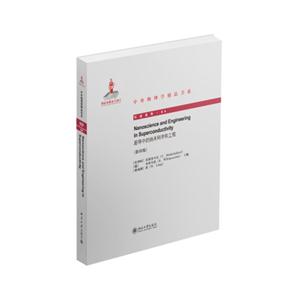超导中的纳米科学和工程-(影印版)
本书特色
[
作为节能技术,更高性能的超导材料成为必要。这些材料可以从纳米单元中发展起来。《超导中的纳米科学和工程(英文影印版)》讲述了如何用纳米技术和纳米尺度的磁模板来修正超导物质。内容包括基本纳米效应、涡旋、涡旋-反涡旋模型、涡旋动力学、约瑟夫森现象和临界电流等。本书适合本领域的研究者和研究生阅读。
]
内容简介
[
超导与纳米工程都是当前物理学和材料、工程等方面的研究热点,二者的结合自然更加受人关注。本书作为这一方面的专著,罗列并讲解了众多技术。对于这方面的研究者帮助会很大。
]
目录
1 guided vortex motion and vortex ratchetsin nanostructured superconductors alejandro v. silhanek, joris van de vondel,and victor v. moshchalkov1.1 introduction. 1.2 equation of motion 1.3 guided vortex motion 1.3.1 transverse electric field and guided vortex motion.. 1.3.2 experimental results and theoretical investigations. 1.4 ratchets 1.4.1 basic ingredients 1.4.2 experimental considerations 1.4.3 experimental results and theoretical investigations. 1.5 conclusion references 2 high-tc films: from natural defects to nanostructureengineering of vortexmatter roger w¨ordenweber2.1 introduction. 2.2 vortex matter in high-tc superconductors 2.2.1 vortex motion in ideal superconductors 2.2.2 flux pinning and summation theories 2.2.3 pinning mechanism in hts. 2.3 vortex manipulation in hts films 2.3.1 vortex manipulation via artificial structures 2.3.2 theoretical considerations of vortexmanipulation via antidots 2.3.3 experimental demonstration.. 2.4 vortex matter in superconducting devices 2.4.1 low-frequency noise in squids 2.4.2 vortex matter in microwave devices 2.5 conclusions. references 3 ion irradiation of high-temperature superconductorsand its application for nanopatterning. wolfgang lang and johannes d. pedarnig3.1 introduction. 3.2 defect creation by ion irradiation.. 3.2.1 methods. 3.2.2 ion species 3.2.3 ion energy dependence. 3.2.4 angle dependence.. 3.2.5 experimental results 3.3 electrical properties after ion irradiation 3.3.1 brief review 3.3.2 experimental techniques 3.3.3 resistivity 3.3.4 hall effect 3.3.5 long-term stability 3.4 nano-patterning by masked ion beam irradiation 3.4.1 previous attempts to nanopatterning of hts 3.4.2 computer simulation results 3.4.3 experimental patterning tests3.5 conclusions and outlookreferences4 frontiers problems of the josephson effect: frommacroscopic quantum phenomena decayto high-tc superconductivity.antonio barone, floriana lombardi, and francesco tafuri4.1 introduction.4.2 grain boundary junctions: the tool4.3 retracing d-wave order parameter symmetryin josephson structures4.4 macroscopic quantum phenomena in josephsonsystems: fundamentals and low critical temperaturesuperconductor junctions..4.4.1 resistively and capacitively shunted junctionmodel and the “washboard” potential.4.4.2 macroscopic quantum tunnelling (mqt)and energy level quantization (elq)4.4.3 developments of quantum measurementsformacroscopic quantum coherence experiments4.5 macroscopic quantum effects in high-tc josephsonjunctions and in unconventionalconditions4.5.1 macroscopic quantum phenomenain high-tc josephson junctions4.5.2 switching current statistics in moderatelydamped josephson junctions4.5.3 mqt current bias modulation4.6 mesoscsopic effects and coherence in htsnanostructures..4.7 conclusions.references5 intrinsic josephson tunneling in high-temperaturesuperconductorsa. yurgens and d. winkler5.1 introduction.5.2 sample fabrication.5.2.1 simple mesa5.2.2 flip-chip zigzag bridges5.2.3 other methods5.3 electrical characterization.5.3.1 i-v curves of intrinsic josephson junctions in bi22125.3.2 critical current density of individual cuo plane5.3.3 superconducting critical currentof individual cuo planes in bi22125.3.4 tunneling spectroscopy.5.3.5 thz radiation5.3.6 joule heating in mesas5.3.7 the c-axis positive and negative magneto-resistance in a perpendicular magneticfield5.4 summary.references6 stacked josephson junctionss. madsen, n.f. pedersen, and p.l. christiansen6.1 introduction.6.2 model6.2.1 numerical method.6.2.2 analytic solutions.6.3 bunching of fluxons.6.3.1 bunching due to coupling between equations6.3.2 bunching due to boundary conditions6.3.3 external microwave signal6.3.4 external cavity6.4 experimentalwork6.5 summary.references7 point-contact spectroscopy of multigap superconductorsp. samuely, p. szab?o, z. pribulov?a, and j. kaˇcmarˇc??k7.1 point-contact andreev reflexion spectroscopy.7.2 two gaps in mgb2 and doped mgb2 systems7.2.1 mgb27.2.2 aluminum and carbon-dopedmgb27.3 multiband superconductivity in the 122-type iron pnictides7.4 conclusions.references8 nanoscale structures and pseudogap in under-dopedhigh-tc superconductorsm. saarela and f.v. kusmartsev8.1 introduction.8.2 microscopic origin of two types of charge carriers.8.3 pseudogap and two types of charge carriers8.4 nanostructures in stm measurements..8.5 conclusions.references9 scanning tunneling spectroscopy of high tc cupratesivan maggio-aprile, christophe berthod, nathan jenkins,yanina fasano, alexandre piriou, and ?ystein fischer9.1 introduction.9.2 basic principles of the stm/sts technique9.2.1 operating principles9.2.2 topography9.2.3 local tunneling spectroscopy.9.2.4 sts of superconductors..9.3 spectral characteristics of hts cuprates9.3.1 general spectral features of hts cuprates.9.3.2 superconducting gap and pseudogap9.4 revealing vortices and the structureof their cores by sts9.4.1 vortex matter in conventional superconductors.9.4.2 vortex matter in hts.9.4.3 electronic structure of the cores9.5 local electronic modulations seen by stm.9.5.1 local modulations of the superconducting gap9.5.2 local modulations of the dos9.5.3 summary.references10 scanning tunnelling spectroscopy of vorticeswith normal and superconducting tipsj.g. rodrigo, h. suderow, and s. vieira10.1 introduction.10.2 experimental: low temperature stmwith superconducting tips10.2.1 low temperature stm.10.2.2 tips preparation and characterization..10.2.3 spectroscopic advantages of superconducting tips10.3 vortices studied by sts10.3.1 the vortex lattice: general propertiesand visualization10.3.2 nbse2 studied with normaland superconducting tips.10.3.3 nbse2 vs. nbs210.3.4 the vortex lattice in thin films: a 2d vortex lattice10.4 other scenarios for the interplay of magnetismand superconductivity10.5 summary and prospects.references11 surface superconductivity controlled by electric fieldpavel lipavsk?y, jan kol?aˇcek, and klaus morawetz11.1 introduction..11.2 limit of large thomas-fermi screening length11.3 de gennes approach to the boundary condition11.4 link to the limit of large screening length11.5 electric field effect on surface superconductivity11.5.1 nucleation of surface superconductivity11.5.2 solution in dimensionless notation11.5.3 surface energy..11.6 magneto-capacitance.11.6.1 discontinuity in magneto-capacitance11.6.2 estimates of magnitude11.7 summary.references12 polarity-dependent vortex pinningand spontaneous vortex-antivortex structuresin superconductor/ferromagnet hybridssimon j. bending, milorad v. miloˇsevi?c,and victor v. moshchalkov12.1 introduction..12.2 theoretical description of f-s hybrids12.2.1 ginzburg-landau theory.12.2.2 london theory12.3 experimental results.12.3.1 scanning hall probe imaging.12.3.2 low moment dot arrays with perpendicularmagnetisation.12.3.3 high moment dot arrays with perpendicularmagnetisation.12.3.4 high moment arrays with in-plane magnetisation.12.4 conclusions.references13 superconductor/ferromagnet hybrids: bilayersand spin switchingj. aarts, c. attanasio, c. bell, c. cirillo, m. flokstra,and j.m.v.d. knaap13.1 introduction..13.2 some history of the field.13.3 sample preparation and ferromagnet characteristics13.4 interface transparency.13.5 domain walls in s/f bilayers13.5.1 domainwalls in nb/cu43ni5713.5.2 domainwalls in nb/py13.6 on the superconducting spin switch13.6.1 spin switch effects with cuni13.6.2 spin switch effects with py13.7 concluding remarks.references14 interplay between ferromagnetism andsuperconductivityjacob linder and asle sudb?14.1 introduction.14.2 artifical synthesis: fjs hybrid structures14.2.1 basic physics14.2.2 quasiclassical theory14.2.3 fjs bilayers14.2.4 sjfjs josephson junctions14.2.5 fjsjf spin-valves.14.2.6 future prospects14.3 intrinsic coexistence: ferromagnetic superconductors14.3.1 experimental results14.3.2 phenomenological framework.14.3.3 probing the pairing symmetry.14.3.4 future prospectsreferencesindex
封面

书名:超导中的纳米科学和工程-(影印版)
作者:莫斯查可夫
页数:395
定价:¥130.0
出版社:北京大学出版社
出版日期:2014-12-01
ISBN:9787301251812
PDF电子书大小:82MB 高清扫描完整版
